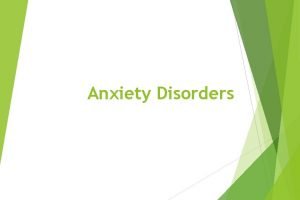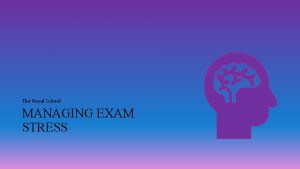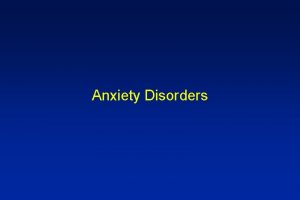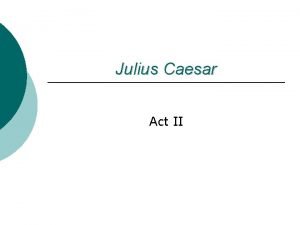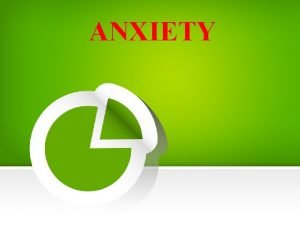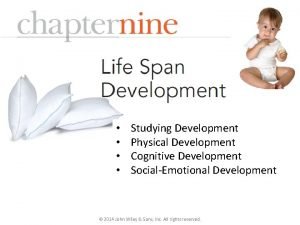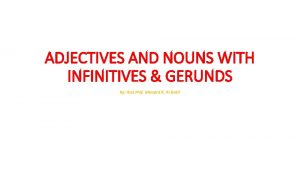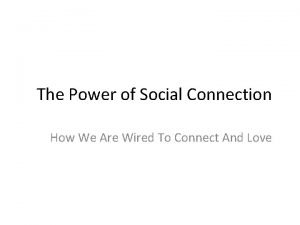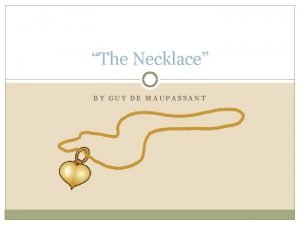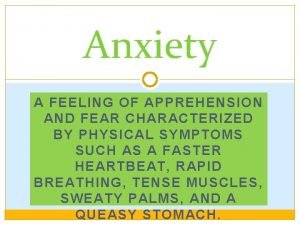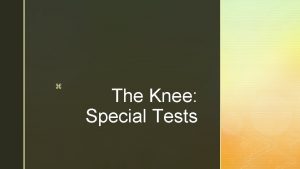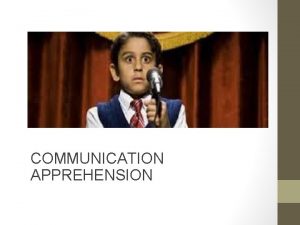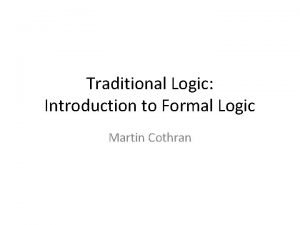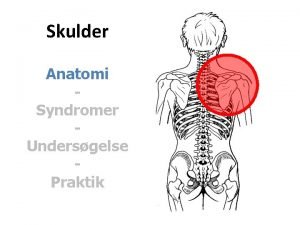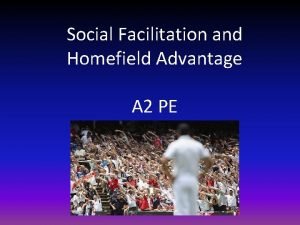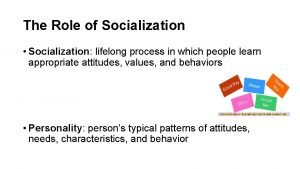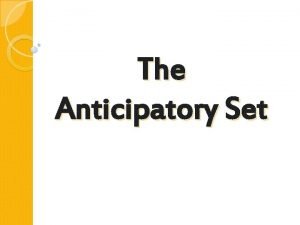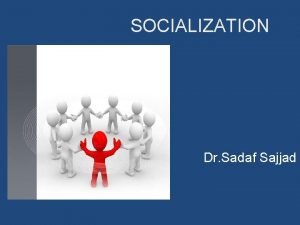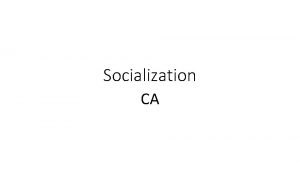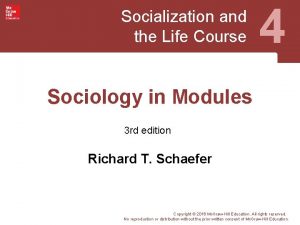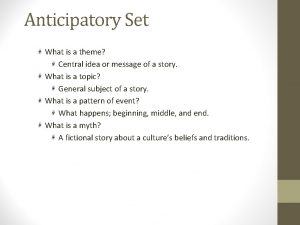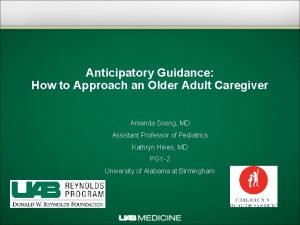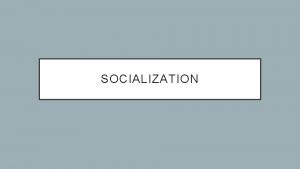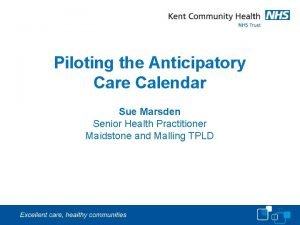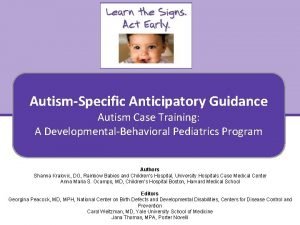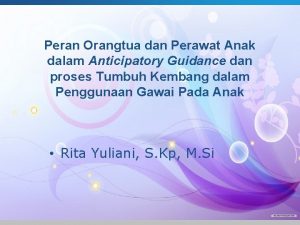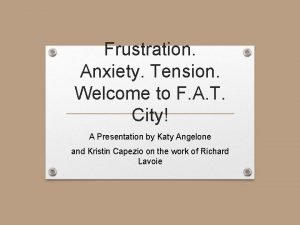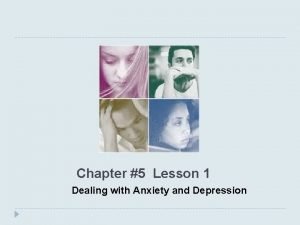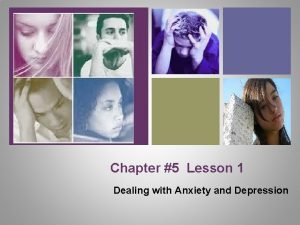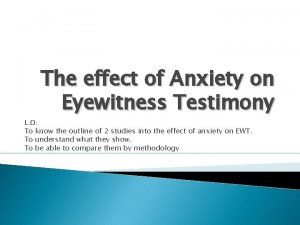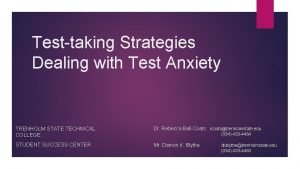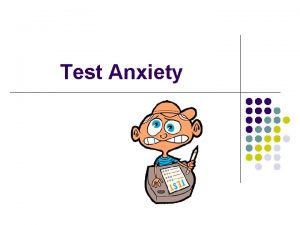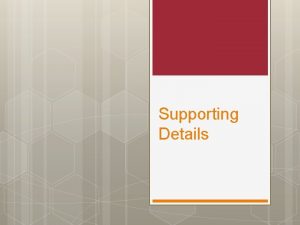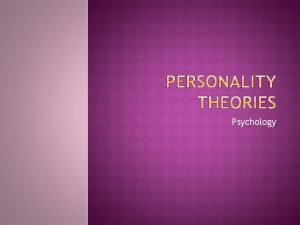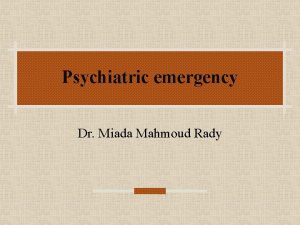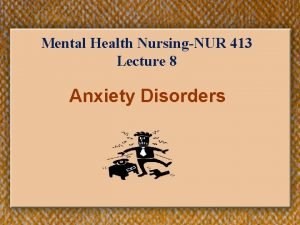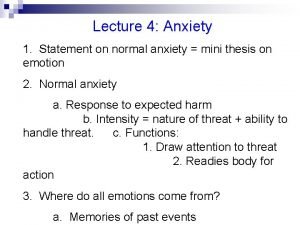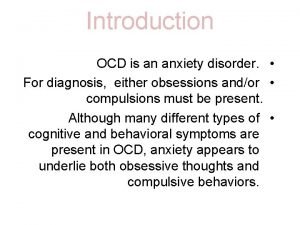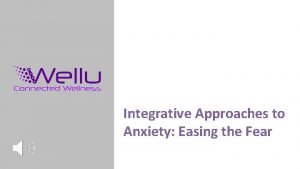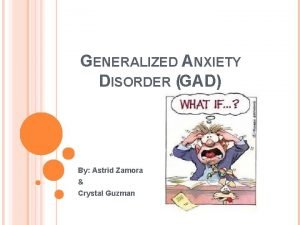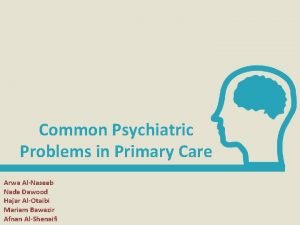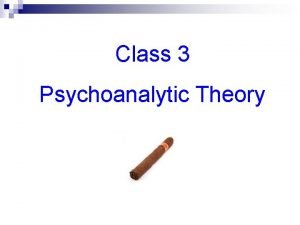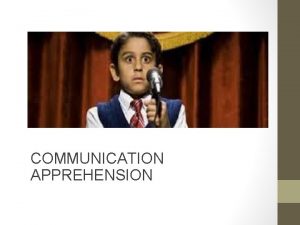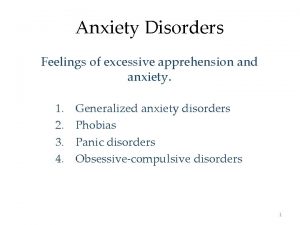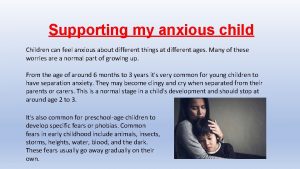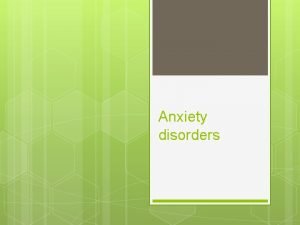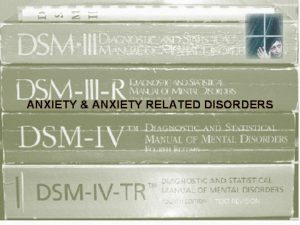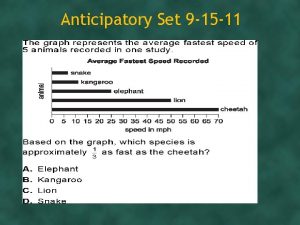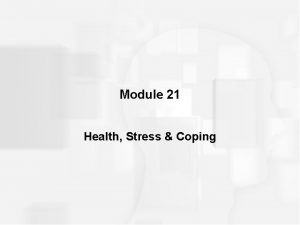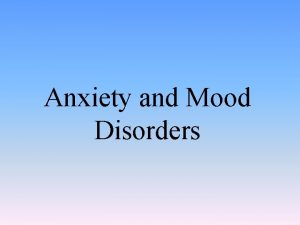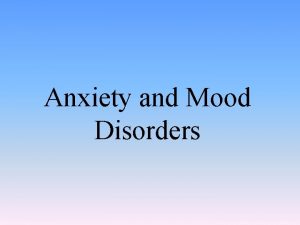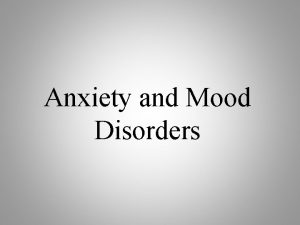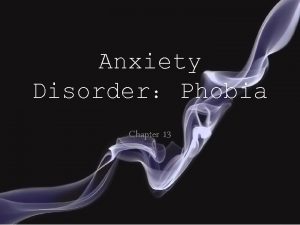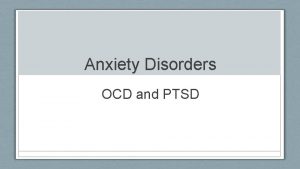Anxiety and Stress Anxiety Apprehension Anticipatory Anxious Apprehension



























































- Slides: 59

Anxiety and Stress

Anxiety Apprehension • Anticipatory - “Anxious Apprehension” • Future-oriented mood state in which one is ready or prepared to attempt to cope with upcoming negative events. • State of undirected arousal following perception of threat

Anxiety: It is an emotion? Specific event Physiological arousal Subjective feelings Behavior Cognitive Appraisals How are fear and anxiety different?

Fear “Something bad now, very soon” Anxiety “Something bad in the future” Cognitive Appraisals Controllable, Novel, Unexpected, Can Cope, Close in Time. Uncontrollable, Unexpected, Can’t Cope, Far In Time Physiology Weak limbs, heart races, dry mouth Tension Behavior Flee, desire to escape, can cope successfully! Limited responses, can’t cope, don’t know how to cope Subjective Feelings Timing Unpleasant, highly arousing Occurs post-stimulus Unpleasant highly arousing, helplessness Occurs pre-stimulus Cognitive Appraisals

Attention: Fear vs. Anxiety • Fear: • Focuses our attention to threatening stimuli • Post-Stimulus • Anxiety: • Focuses our attention to threatening stimuli • Maintains our attention to threatening stimuli, especially highly fearful stimuli • Pre-stimulus

Genetic Structure: Anxiety vs. Fear Animal Phobia Situational Social Phobia Anxiety Panic & Agor. PTSD GAD Depression (Hettema et al. , 2005)

Brain Activation: Anxiety versus Fear (Davis & colleagues, 1998, 2003)

When fear becomes anxiety Anxiety = unresolved fear When the coping attempts for fear fail Often in uncontrollable situation

Is Anxiety a Basic Emotion? A few say yes! – Gray’s BIS More say no! – Ekman, Izard, and Williams James! – No universal facial expressions. – But, universal appraisals.

Physiological Changes SNS Activated PNS Activated What can anxiety disorders tell us about physiological changes of anxiety?

With PTSD Without PTSD With Previous PTSD Physiological Measures

Audiovisual Stimulus 3 Imagery 4 3 2 Current PTSD 2 Previous PTSD 1 Never PTSD 1 BP e at rtr H ea BP SC R e at rtr H ea SC R 0 0

Subjective Feelings Audiovisual Stimulus Imagery Stimulus 100 11 80 9 60 7 40 Subjective 5 Distress Subjective Unpleasantness 3 20 TS D us P TS N D ev er P TS D 1 Pr e vi o nt rre Cu Current Previous Never PTSD P 0

Stressful Math Task 10 8 6 Current PTSD Previous PTSD 4 Never PTSD 2 0 Heartrate SCR BP

Physiological Arousal Fear Response Anxiety Response Combo!

What is the purpose of anxiety? Automatic Processing: To detect/anticipate potential threats in our environment Maintains our attention toward threatening stimuli (less likely to disengage) To be aware of objects we consider most dangerous (e. g. , phobias)

Automatic Processing and Threat Detection Automatic, non-conscious mental activity gives us early warning system for detecting threat Implication: You can know and not know something at the same time--not know it consciously, know it unconsciously Basic technique: Backward masking

Backward Masking 1. Present picture of threatening stimulus very quickly (30 milliseconds) 2. Immediately after threat photo is shown, show a non-threatening picture. The second picture is a mask, blocks first picture from consciousness. 3. Reaction to first (masked) picture indicates unconscious processing

Automatic Processing of Fearful Stimuli: Results of Masked Stimuli Only

Anxiety Maintains Attention / Harder to Disengage Dot Probe Detection Paradigm Present two words above a cross. Words were threatening or neutral. Position of words varied. A dot replaces one of two words. Sometimes dot replaces threatening word. Sometimes dot replaces neutral word. Told to read top word aloud. Press button when see the dot. Measure reaction time to locating dot.

Dot probe detection paradigm

Dot probe detection paradigm AGONY FLOOR

Dot probe detection paradigm

Dot probe detection paradigm

Dot probe detection paradigm AGONY FLOOR

Dot probe detection paradigm

Anxiety Maintains Attention / Harder to Disengage 700 650 600 Reaction Time 550 500 Dots Replace Threatening Word 450 Dots Replace Neutral Word 400 350 300 250 200 GAD Control (Mac. Leod et al. , 1986)

Dot probe detection paradigm (Bradley et al. , 1998)

Dot probe detection paradigm

Dot probe detection paradigm

Dot probe detection paradigm

Fear or Anxiety? Cut the rope! How to sing Cinderella Man Jurassic Park

Anxiety: It is an emotion? Specific event Physiological arousal Behavior Appraisals Subjective feelings

Is stress an emotion? Specific event Physiological arousal Behavior Appraisals Subjective feelings © 2015 M. Guthrie Yarwood 34

ACTIVATION PIN YOUR ANSWER! 1 INTRO VIDEO 2 PLEASANT UNPLEASANT 4 3 DEACTIVATION

PIN YOUR ANSWER! High PA PLEASANT 2 Low NA 8 1 7 6 Strong Engagement 3 4 5 High NA UNPLEASANT Disengagement Low PA

Views of Stress Seyle: stress is a response to significant changes in life events – Stress is a Basic Emotion! Lazarus: stress is our interpretation of an event as threatening PLUS our perceived ability to cope – Stress is a mixed emotion! © 2015 M. Guthrie Yarwood 37

GENERAL ADAPTATION SYNDROME (Selye, 1974) Evidence for GAS: Cortisol © 2015 M. Guthrie Yarwood 38

Action Unit 4 – Brow Lowerer Action Unit 12 – Lip Corner Pull Action Unit 26 – Jaws Drop Action Unit 25 – Lips part Lazarus © 2015 M. Guthrie Yarwood 39

0. 6 Cortisol Changes – Onset of Stressor Effect size (d) 0. 5 *** 0. 4 *** 0. 3 0. 2 *** ** 0. 1 0 1 -10 11 -20 21 -30 31 -40 Minutes 41 -50 51 -60 (Dickerson & Kemeny, 2004) © 2015 M. Guthrie Yarwood 40

Cortisol Recovery 0. 5 0. 4 *** Effect size (d) 0. 3 0. 2 0. 1 0 0 -20 Min Poststressor 21 -40 Min Poststressor 41 -60 Poststressor -0. 1 -0. 2 Evidence for GAS: Vagal Tone (Dickerson & Kemeny, 2004) © 2015 M. Guthrie Yarwood 41

Low Stress Mean Stress High Stress Daily Negative Emotional Arousal 2. 6 2. 1 1. 6 Low Mean Level of Vagal Tone High (Fabes & Eisenberg, 1997) © 2015 M. Guthrie Yarwood 42

Low Stress Mean Stress High Stress Daily Negative Emotional Arousal 2. 6 2. 1 1. 6 Low Mean Level of Vagal Tone High (Fabes & Eisenberg, 1997) © 2015 M. Guthrie Yarwood 43

Low Stress Mean Stress High Stress Daily Negative Emotional Arousal 2. 6 2. 1 1. 6 Low Mean Level of Vagal Tone High (Fabes & Eisenberg, 1997) © 2015 M. Guthrie Yarwood 44

Primary Appraisal: perceive a threat to oneself Secondary Appraisal: assess whether one has the resources to cope with the threat Coping: process of executing a response to the stressor. (Lazarus, 1966; Lazarus & Folkman, 1984) © 2015 M. Guthrie Yarwood 45

Primary Appraisal: Not passing my qualifying exams Secondary Appraisal: Can I handle this? I can make a study schedule! Coping: Study everyday from 8 -5 and take off on Wednesday © 2015 M. Guthrie Yarwood (Lazarus, 1966; Lazarus & Folkman, 1984) Evidence for Lazarus 46

Think about your first exam. Thursday • Anticipating the exam… • Emotions? Saturday • Waiting for your grade… • Emotions? Tuesday • Good grade! • Emotions? © 2015 M. Guthrie Yarwood 47

Think about your first exam. Thursday • Anticipating the exam… • Emotions? Saturday • Waiting for your grade… • Emotions? Tuesday • Good grade or bad grade? • Emotions? © 2015 M. Guthrie Yarwood 48

4 Types of Stress Emotions Appraisal Threat Challenge Harm Emotion Worried, fearful, anxious Confident, hopeful, eager Angry, sad, disappointed, guilty, disgusted Benefit Exhilarated, pleased, happy, relieved (Folkman & Lazarus, 1985) © 2015 M. Guthrie Yarwood 49

Stress is an unfolding process T 1 • Anticipatory Stage • 2 days before mid-term T 2 • Waiting Stage • 5 days after mid-term T 3 • Outcome Stage • 2 days before grades announced (Folkman & Lazarus, 1985) © 2015 M. Guthrie Yarwood 50

Appraisal Emotion Threat Worried, fearful, anxious Challenge Confident, hopeful, eager Extent feel each emotion (Range 0 to 12) 5 4 3 Threat Challenge 2 1 0 Anticipatory Waiting Outcome (Folkman & Lazarus, 1985) © 2015 M. Guthrie Yarwood 51

Emotion Harm Angry, sad, disappointed, guilty, disgusted Benefit Exhilarated, pleased, happy, relieved 6 5 4 3 2 1 0 O ut co m g tin W ai or at ip ic A nt e Harm Benefit y Extent feel each emotion (Range 0 to 16/20) Appraisal (Folkman & Lazarus, 1985) © 2015 M. Guthrie Yarwood Evidence for Lazarus: Coping 52

ANS Activity Varies with Appraisal Threat Appraisal – Increases in SNS arousal (increased cardiac activity) – Increases in PNS resistance(increased blood pressure) Challenge Appraisal – Increases in SNS arousal (increased cardiac activity) – Reduced or unchanged PNS activity © 2015 M. Guthrie Yarwood 53

Do you want to change your answer? ACTIVATION 1 2 PLEASANT UNPLEASANT 4 3 DEACTIVATION

High PA 2 PLEASANT Low NA 8 1 7 6 Strong Engagement 3 4 5 High NA UNPLEASANT Disengagement Low PA

THREAT CHALLENGE

HARM BENEFIT relieved

T A RE TH E EN G A LL CH

EF IT RM IT A EF BE N H BENEFIT H relieved A RM
 Anxiety vs apprehension
Anxiety vs apprehension Chapter 8 managing stress and anxiety
Chapter 8 managing stress and anxiety Anxiety symptoms
Anxiety symptoms Stress anxiety depression
Stress anxiety depression Apprehensive vs anxious
Apprehensive vs anxious What promise does brutus make to rome
What promise does brutus make to rome Anxious arousal meaning
Anxious arousal meaning Longitudinal vs cross sectional
Longitudinal vs cross sectional Perfect passive gerund
Perfect passive gerund Anxious gerund or infinitive
Anxious gerund or infinitive Anxious attachment style
Anxious attachment style Do you think m loisel enjoyed the ball
Do you think m loisel enjoyed the ball Psalms 94 17
Psalms 94 17 True
True Chapter 10 stress responses and stress management
Chapter 10 stress responses and stress management Extreme fear and apprehension
Extreme fear and apprehension Axial stress vs normal stress
Axial stress vs normal stress Apprehension test knee
Apprehension test knee Sulcus sign
Sulcus sign Communication apprehension definition
Communication apprehension definition Define evaluation apprehension
Define evaluation apprehension Particular term in logic example
Particular term in logic example Supraspinatus triggerpunkt
Supraspinatus triggerpunkt Evaluation apprehension pe
Evaluation apprehension pe Socialization examples
Socialization examples Anticipatory set meaning
Anticipatory set meaning Example of anticipatory socialization
Example of anticipatory socialization Jean piaget theory of socialization
Jean piaget theory of socialization Anticipatory socialization
Anticipatory socialization Anticipatory set
Anticipatory set Anticipatory guidance for adults
Anticipatory guidance for adults Peer group
Peer group Anticipatory care calendar
Anticipatory care calendar Anticipatory guidance for autism
Anticipatory guidance for autism Anticipatory set examples
Anticipatory set examples Braden kay
Braden kay Anticipatory care definition
Anticipatory care definition Leaflet anticipatory guidance
Leaflet anticipatory guidance What is anticipatory bail
What is anticipatory bail Define anticipatory set
Define anticipatory set Frustration anxiety and tension
Frustration anxiety and tension Chapter 15 anxiety and obsessive-compulsive disorders
Chapter 15 anxiety and obsessive-compulsive disorders Chapter 5 lesson 1 dealing with anxiety and depression
Chapter 5 lesson 1 dealing with anxiety and depression Chapter 5 lesson 1 dealing with anxiety and depression
Chapter 5 lesson 1 dealing with anxiety and depression Crisis development model directive staff approach
Crisis development model directive staff approach How anxiety affects eyewitness testimony
How anxiety affects eyewitness testimony Relaxation techniques test anxiety
Relaxation techniques test anxiety Anxiety symptoms
Anxiety symptoms I'm a perfect example of someone who has math anxiety
I'm a perfect example of someone who has math anxiety Neurotic behavior
Neurotic behavior Neurotic definition
Neurotic definition Ineffective coping short term goals
Ineffective coping short term goals Examples of generalized anxiety disorder
Examples of generalized anxiety disorder Neurotic anxiety example
Neurotic anxiety example Dystonic vs syntonic
Dystonic vs syntonic University of wisconsin integrative medicine anxiety
University of wisconsin integrative medicine anxiety Examples of generalized anxiety disorder
Examples of generalized anxiety disorder Sharat chandran
Sharat chandran Generalized anxiety disorder dsm 5
Generalized anxiety disorder dsm 5 Define neurotic
Define neurotic
